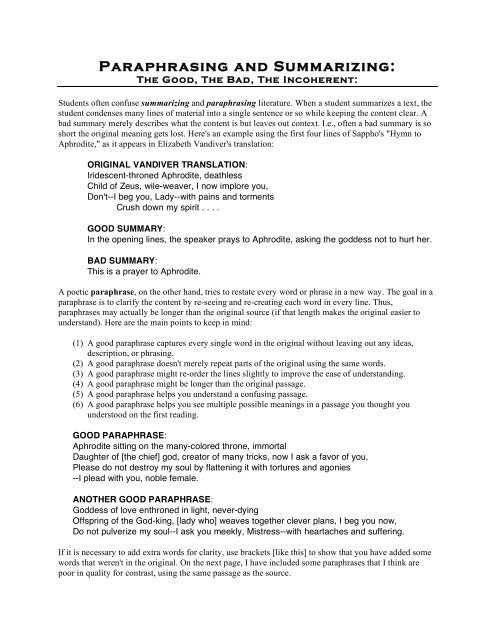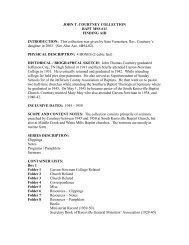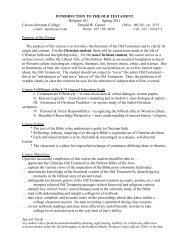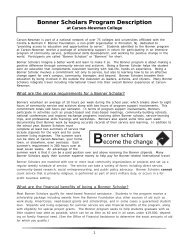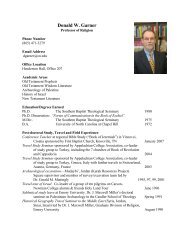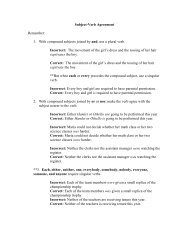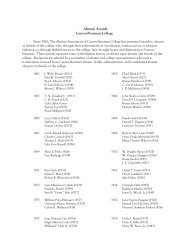Paraphrasing and Summarizing:
Paraphrasing and Summarizing:
Paraphrasing and Summarizing:
- No tags were found...
You also want an ePaper? Increase the reach of your titles
YUMPU automatically turns print PDFs into web optimized ePapers that Google loves.
<strong>Paraphrasing</strong> <strong>and</strong> <strong>Summarizing</strong>:The Good, The Bad, The Incoherent:Students often confuse summarizing <strong>and</strong> paraphrasing literature. When a student summarizes a text, thestudent condenses many lines of material into a single sentence or so while keeping the content clear. Abad summary merely describes what the content is but leaves out context. I.e., often a bad summary is soshort the original meaning gets lost. Here's an example using the first four lines of Sappho's "Hymn toAphrodite," as it appears in Elizabeth V<strong>and</strong>iver's translation:ORIGINAL VANDIVER TRANSLATION:Iridescent-throned Aphrodite, deathlessChild of Zeus, wile-weaver, I now implore you,Don't--I beg you, Lady--with pains <strong>and</strong> tormentsCrush down my spirit . . . .GOOD SUMMARY:In the opening lines, the speaker prays to Aphrodite, asking the goddess not to hurt her.BAD SUMMARY:This is a prayer to Aphrodite.A poetic paraphrase, on the other h<strong>and</strong>, tries to restate every word or phrase in a new way. The goal in aparaphrase is to clarify the content by re-seeing <strong>and</strong> re-creating each word in every line. Thus,paraphrases may actually be longer than the original source (if that length makes the original easier tounderst<strong>and</strong>). Here are the main points to keep in mind:(1) A good paraphrase captures every single word in the original without leaving out any ideas,description, or phrasing.(2) A good paraphrase doesn't merely repeat parts of the original using the same words.(3) A good paraphrase might re-order the lines slightly to improve the ease of underst<strong>and</strong>ing.(4) A good paraphrase might be longer than the original passage.(5) A good paraphrase helps you underst<strong>and</strong> a confusing passage.(6) A good paraphrase helps you see multiple possible meanings in a passage you thought youunderstood on the first reading.GOOD PARAPHRASE:Aphrodite sitting on the many-colored throne, immortalDaughter of [the chief] god, creator of many tricks, now I ask a favor of you,Please do not destroy my soul by flattening it with tortures <strong>and</strong> agonies--I plead with you, noble female.ANOTHER GOOD PARAPHRASE:Goddess of love enthroned in light, never-dyingOffspring of the God-king, [lady who] weaves together clever plans, I beg you now,Do not pulverize my soul--I ask you meekly, Mistress--with heartaches <strong>and</strong> suffering.If it is necessary to add extra words for clarity, use brackets [like this] to show that you have added somewords that weren't in the original. On the next page, I have included some paraphrases that I think arepoor in quality for contrast, using the same passage as the source.
ORIGINAL VANDIVER TRANSLATION:Iridescent-throned Aphrodite, deathlessChild of Zeus, wile-weaver, I now implore you,Don't--I beg you, Lady--with pains <strong>and</strong> tormentsCrush down my spirit . . . .BAD PARAPHRASE #1 (too close to original):Iridescent-throned Aphrodite, immortalChild of Zeus, I now beg you, wile-weaverDon't--I implore you, Lady--with torments <strong>and</strong> painsCrush down my spirit.BAD PARAPHRASE #2 (leaving out important ideas, words, or concepts)Aphrodite sitting on the throne,Divine girl, trickster, I ask youNot to smash me with tortures <strong>and</strong> sorrow.BAD PARAPHRASE #3 (changing from first to third person)The speaker asks Aphrodite on the glowing throne, the un-killableDaughter of Zeus, not to destroy her spirit with agony <strong>and</strong> sorrows.BAD PARAPHRASE #4 (confusing Sappho with the poetic speaker)The poet Sappho must have been having a bad romance, because she asks the love-Goddess on the elaborate throne, the undying Daughter of the sky-God, not to squishher soul with misery <strong>and</strong> pains.Other Tips: (a) On a xerox copy, try underlining the subject of each clause once <strong>and</strong> underline eachsubject's verb(s) twice in the original passage. That will help you really see who's doing what in theoriginal sentence if you don't underst<strong>and</strong> it. (b) Look up words when you don't know the meaning ofthem. (c) When your paraphrase is done, go through your paraphrase <strong>and</strong> compare it to the original oneword at time. Place a checkmark on each word in the original if you can find <strong>and</strong> circle the correspondingpart in your paraphrase that captures that idea. If you can't find a matching section or word in your ownparaphrase, you have a problem. (d) A thesaurus can be a big help if you need to think of another wordfor the original.If you are reading a difficult passage, <strong>and</strong> you can't figure out what it means initially, try paraphrasing it.For a short work, try paraphrasing the entire poem.


